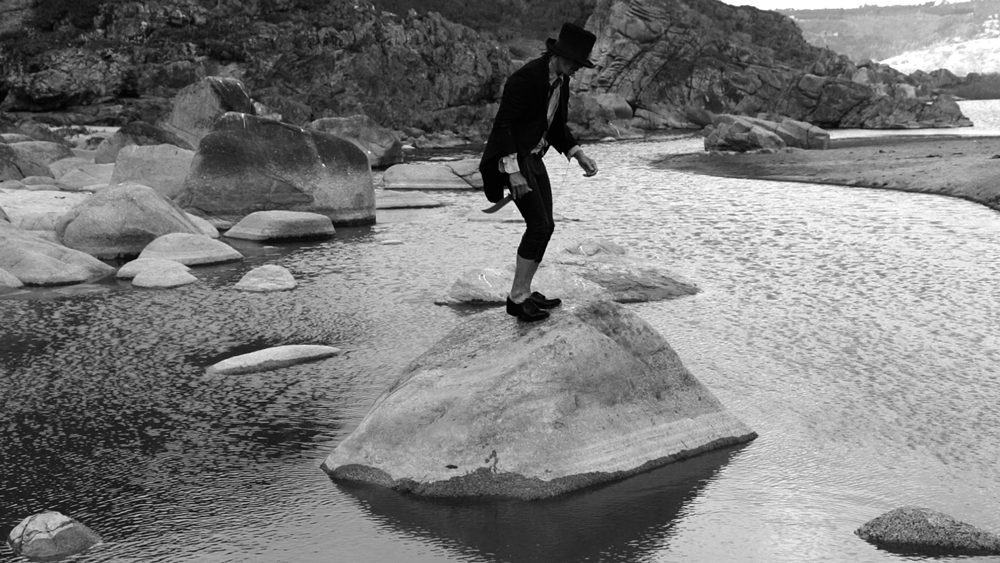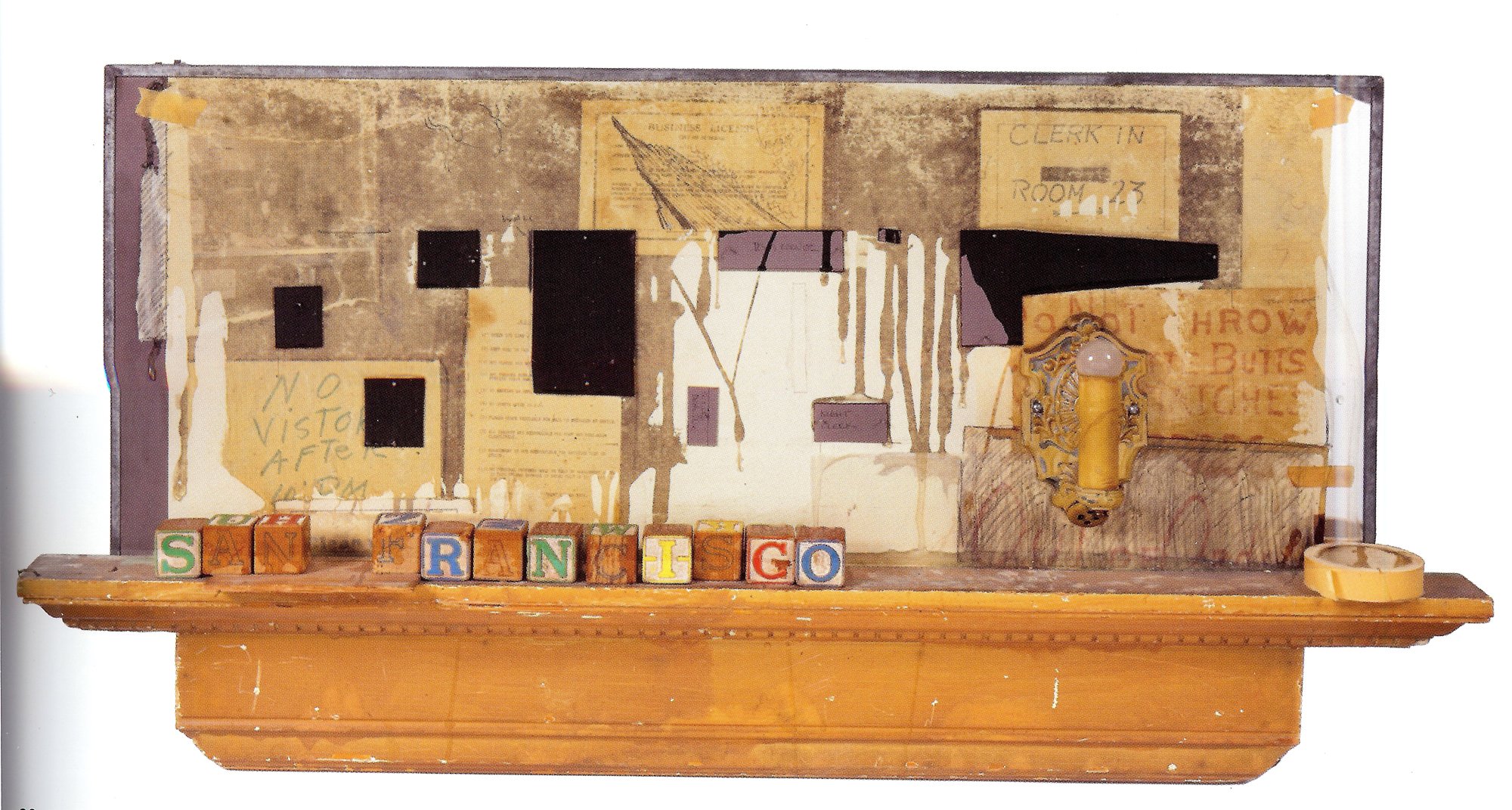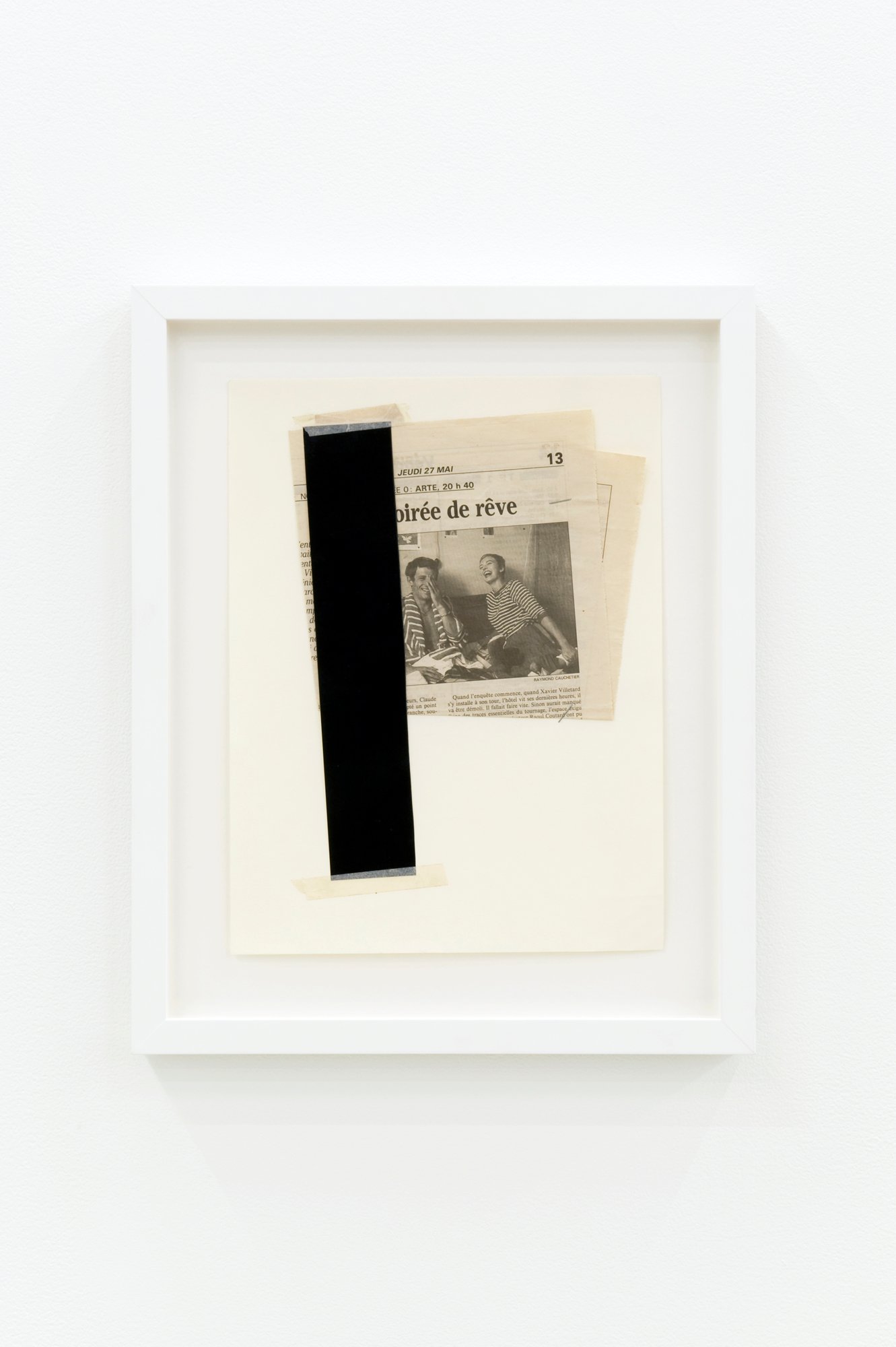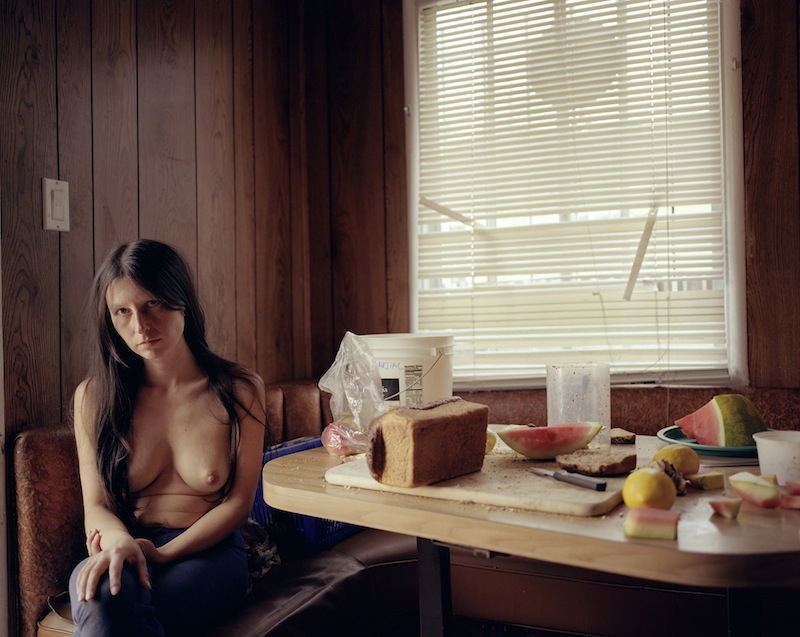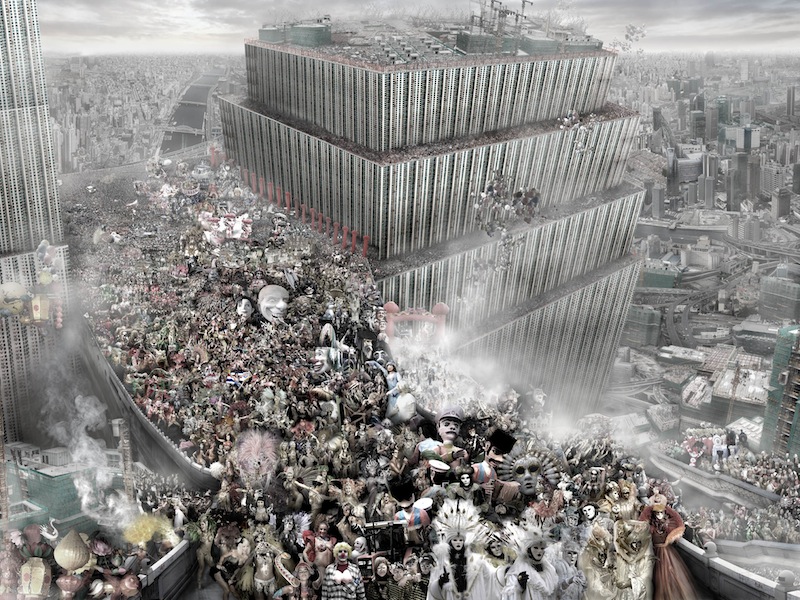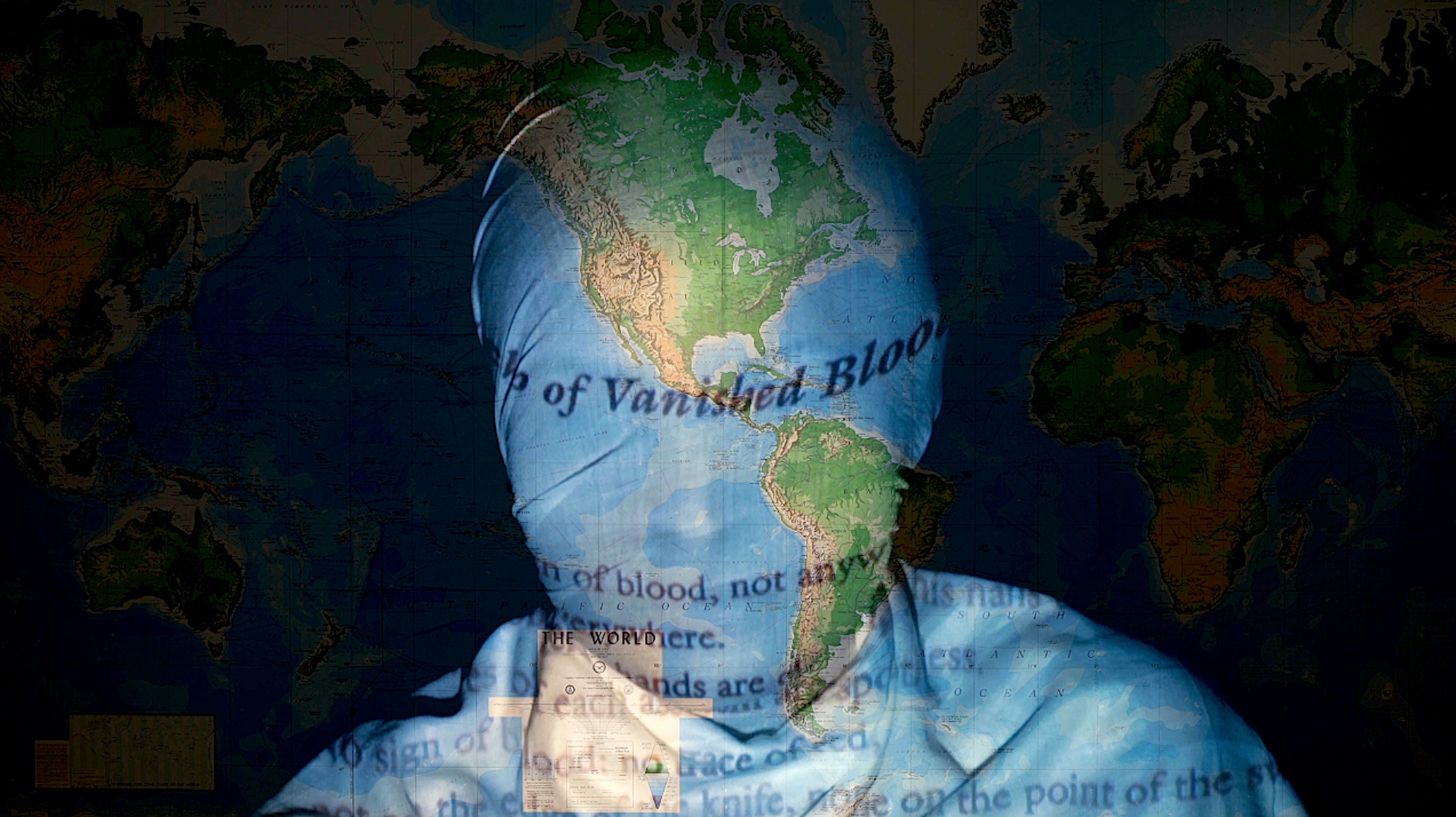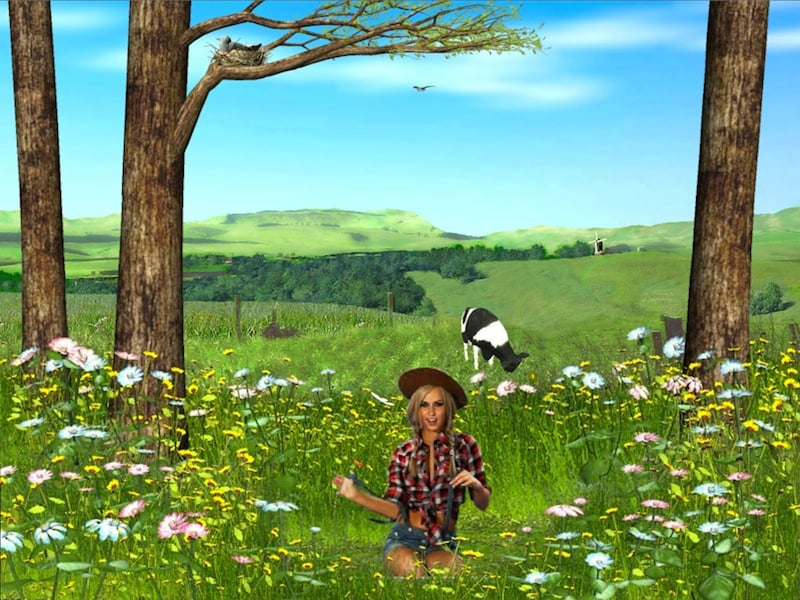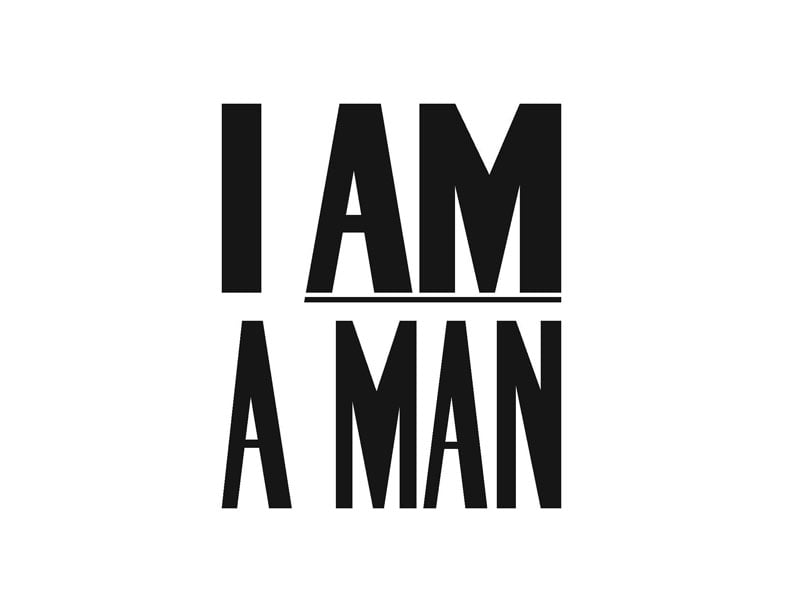
© » KADIST
An-My LE
The print Patient Admission, US Naval Hospital Ship Mercy, Vietnam (2010) features an Asian Buddhist monk and an American Navy Solider on board the Mercy ship –one of the two dedicated hospital ships of the United States Navy– sitting upright in their chairs and adopting the same posture. In the background, the steel pillars creates a division of space implying a separation the two men according to their geographic regions of origin or residence, their vocations, their ethnicities, and their attitudes toward war. Yet, the mirrored body language of the two characters also suggests their reconciliation into a dialogue perhaps characterized by the protagonists’ physical and spiritual conversation.
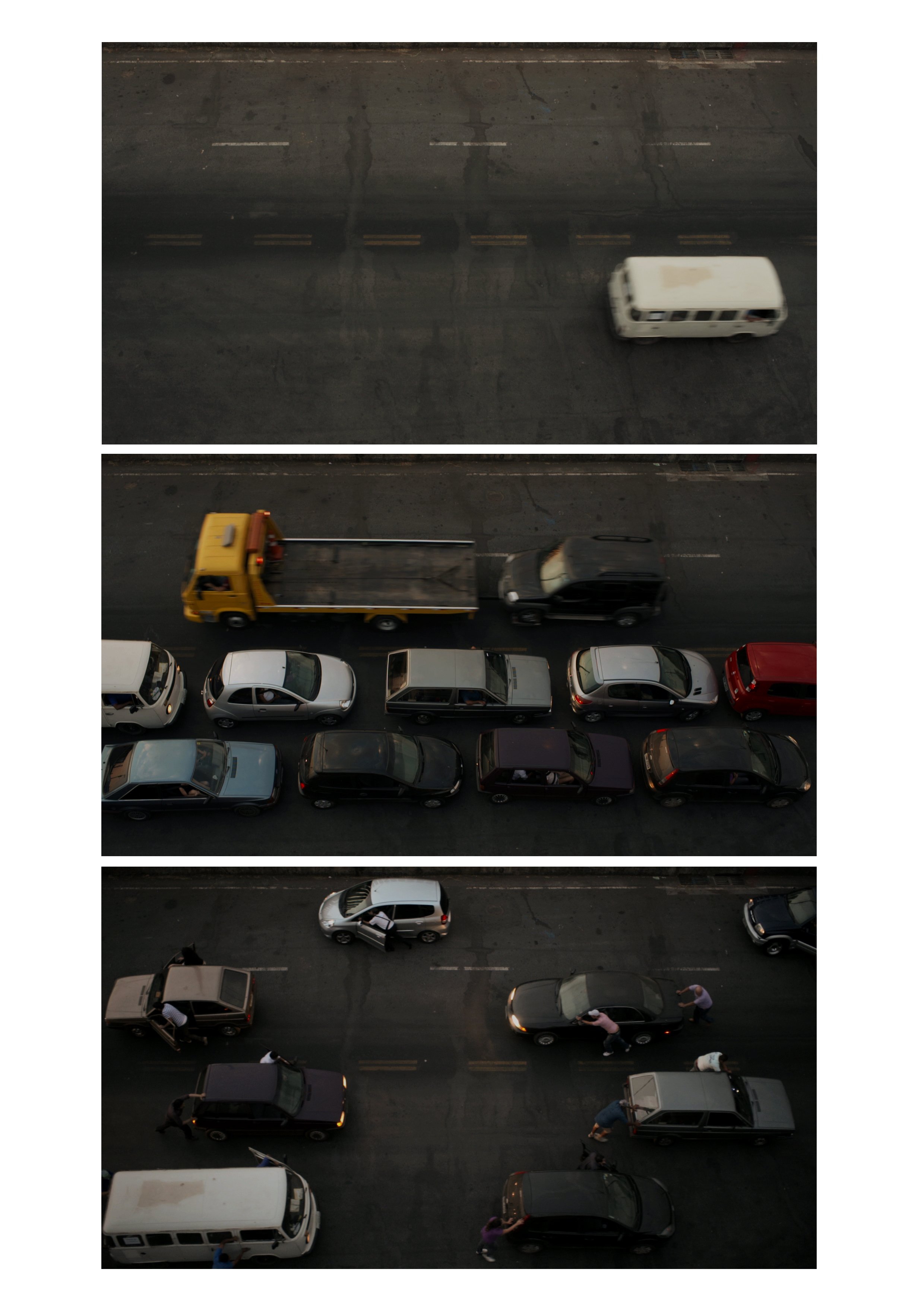
© » KADIST
Cinthia Marcelle
Cinthia Marcelle’s video work Automóvel (2012) re-edits the mundane rhythms of automotive traffic into a highly compelling and seemingly choreographed meditation on sequence, motion, and time. Shot from an aerial vantage, the camera tracks the daily commute on a small stretch of concrete highway. The camera films the traffic below in short five-second excerpts before blacking out; time begins to collapse as the video shifts between scene, and the hours compress into minutes as daylight quickly turns into night.

© » KADIST
Agnieszka Kurant
For Sentimentite Agnieszka Kurant collaborated with Justin Lane, CEO and Co-Founder of CulturePulse, to gather global sentiment data that has been harvested from millions of Twitter and Reddit posts related to 100 seismic events in recent history. Kurant’s fictional mineral-currency is at once data visualization, a sly commentary on global markets, and a speculative narrative about the connection between technology and geology (for example ‘conflict minerals’ used in smartphones). Inspired by the way natural forces shape rocks, landscape, and planets over time, Sentimentite ’s evolving forms are shaped by dynamic social and political ruptures in the 21st century.

© » KADIST
Yang Guangnan
In Action no. 1 Yang Guangnan reflects on the interiority and exteriority of human-technological experience with mechanical gestures that are semi-human and semi-machine. A hanged shirt mounted upon the artist’s machine rhythmically bounces and rotates in a way that suggests a skeletal interior.

© » KADIST
Agnieszka Kurant
For Sentimentite Agnieszka Kurant collaborated with Justin Lane, CEO and Co-Founder of CulturePulse, to gather global sentiment data that has been harvested from millions of Twitter and Reddit posts related to 100 seismic events in recent history. Kurant’s fictional mineral-currency is at once data visualization, a sly commentary on global markets, and a speculative narrative about the connection between technology and geology (for example ‘conflict minerals’ used in smartphones). Inspired by the way natural forces shape rocks, landscape, and planets over time, Sentimentite ’s evolving forms are shaped by dynamic social and political ruptures in the 21st century.

© » KADIST
Walead Beshty
Black Curl (CMY/Five Magnet: Irvine, California, March 25, 2010, Fujicolor Cyrstal Archive Super Type C, EM No 165-021, 05910) is a visually compelling photogram. Bold shapes, and the breaks between them, create a rhythm and compose an engaging abstract image. At the same time, the work deals with the conditions of the photograph’s manufacture.

© » KADIST
Andrea Bowers
Drawing & Print (Drawing & Print)
The small drawings that comprise Study from May Day March, Los Angeles 2010 (Immigration Reform Now) and We Are Immigrants Not Terrorists are based on photographs taken at a political rally in downtown Los Angeles in which thousands of individuals demonstrated for immigrants’ rights. The protesters and their supporters carried signs and wore t-shirts whose messages are highlighted in the drawings. However, in them, Bowers isolates the images of the protesters from the multitude that surrounds them in the original photographs, and, therefore amplifies their messages.

© » KADIST
Kate Gilmore
In the six-minute single-channel video Higher Horse , Kate Gilmore perches herself on top of a tall pile of plaster blocks, in front of a pink colored wall with vein-like streaks of red. Two muscular men with sledgehammers simultaneously pummel the blocks where Gilmore attempts to stand. Although we can only see the artist from the waist down, her body language reveals apprehension: her hands, tense, press against the wall in an attempt to maintain balance while the men come dangerously close to smashing her bare legs.

© » KADIST
Lynn Hershman Leeson
Hershman Leeson’s documentary, Women Art Revolution (W. A. R.) draws from hundreds of hours of intimate interviews with her contemporaries—visionary artists, historians, curators and critics—who recount their fight to break down the barriers facing women both in the art world and society at large. The film features an original score by Carrie Brownstein, formerly of the band Sleater-Kinney.

© » KADIST
Zanele Muholi
As a visual activist for the rights of Lesbian, gay, bisexual, transgender, queer and intersex (LBGTQI), Muholi’s photographs radically transgress the conventional perception of lesbian and transgender communities in South Africa. Members of the LBGTQI community who suffer from continuous attacks — “corrective” and “curative rapes”, physical and psychological assaults, and hate crimes — Muholi works from her own community to create strong and positive images of empowered individuals. As visual statements, her photographs seek to dignify the members of an often hidden, voiceless and marginalized community.
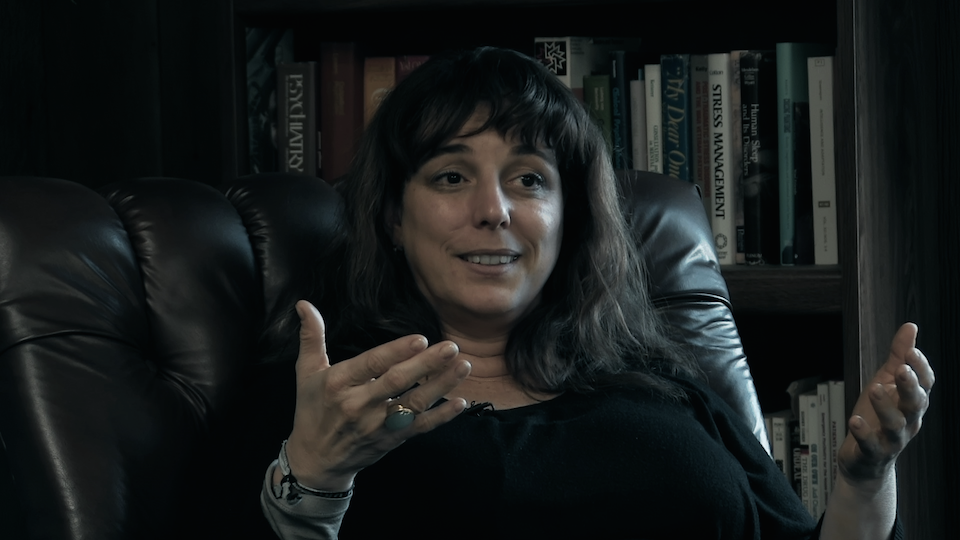
© » KADIST
Lynn Hershman Leeson
Tania Libre is a film by Lynn Hershman Leeson centered around renowned artist Tania Bruguera and her experience as a political artist and activist under the repressive government of her native Cuba. The film begins with the voice of Tilda Swinton narrating a manifesto of artists’ rights written by Bruguera in which she expresses her views on art, our universal right to both enjoy and create art, and the duty that artists have to dissent. The film then captures a series of therapy sessions between Bruguera and Dr. Frank M. Ochberg—the founding father of trauma therapy, particularly PTSD and Stockholm Syndrome—where Bruguera describes with great candor and earnestness several traumatic experiences such as the betrayal by her father who handed her to Cuban secret service, and her imprisonment in Havana years later after advocating for freedom of expression.

© » KADIST
Yoshua Okón
Fridge-Freezer is a 2-channel video installation where Yoshua Okón explores the darker side of suburbia, d escribed by the artist as “ the ideal environment for a numb existence of passive consumerism and social a nd environmental disengagement. ” Filmed at display homes in the suburbs of Manchester in the United Kingdom, the video features real-estate agents clad in bright-red blazers enthusiastically describing features of the ‘dream home’ as they walk through different rooms. A couple of additional elements, a couch and neutral soft carpet, recreate the domestic setting and immerse the viewer in the unfolding scenes.

© » KADIST
Fang Lu
No World is an action-filled video work filmed inside an abandoned museum in the Songzhuang area outside Beijing. Without using any dialogue, Lu created an artificial scenario where she instructed actors with a list of tasks to gesturally mime scenes from news and journalistic images outside China. Through an intuitive self-trained mimicry, these acts simultaneously became moves in a game as well as a daily routine.

© » KADIST
Gimhongsok
To explore the boundaries between artwork and audience, Gimhongsok created a series of sculptural performances in which a person wearing an animal costume poses in the gallery. Bunny’s Sofa is a continuation of this series, but with a different twist. Instead of hiring a real person to dress as the animal, Gimhongsok placed a mannequin inside the rabbit costume.

© » KADIST
Fang Lu
Canton Novelty by Fang Lu captures the adventure of a group of three girls, Ruohan, Lily and Zoe on a summer vacation in Guangzhou, China. Throughout the course of the trip, they film themselves with their cell phones singing in a karaoke room, shopping at a hardware store, sitting at a park, hanging out in a hotel room and exploring a neighborhood looking at vacant apartment ads. Although their days may seem uneventful, the girls seemingly discover the ability to perform impossible “miracles,” including cooking a full pot of rice from three grains, summoning objects to appear and disappear, and turning off street lamps on command.

© » KADIST
Andrea Bowers
Bowers’ Radical Hospitality (2015) is a sculptural contradiction: its red and blue neon letters proclaim the words of the title, signaling openness and generosity, while the barbed wires that encircle the words give another message entirely. Meant to hang from the ceiling, Bowers’ neon is further weighed down by long wind chimes made of aluminum pipes and wooden wind catchers that drip unsteadily from their anchors. Poetic but frantic in its juxtapositions, Bowers’ work captures a certain paradoxical energy that echoes the current political climate—it is hopeful but hindered, cacophonous but well intentioned, uncertain but ominous.

© » KADIST
Hank Willis Thomas
Drawing & Print (Drawing & Print)
Intentionally Left Blanc alludes to the technical process of its own (non)production; a procedure known as retro-reflective screen printing in which the image is only fully brought to life through its exposure to flash lighting. Using a found photograph depicting a passionate crowd of African Americans—their attitude suggesting the fervor of a civil-rights era audience— Intentionally Left Blanc reverts in its exposed, “positive” format to an image in which select faces are whitened out and erased, the exact inverse of the same view in its “negative” condition. This dialectic of light and dark re-emerges when we view the same faces again, only this time black and featureless, a scattering of disembodied heads amidst a sea of white.

© » KADIST
Eko Nugroho
Nugroho’s installations and performances have their roots in the shadow puppet rituals in Indonesia, particularly the Javanese Wayang tradition whose essence is in the representation of the shadows. Nugroho’s work both preserves traditional culture and offers a contemporary interpretation of it through his insertion of comical figures to comment on current social conditions. Moving Landscape includes characters such as a diamond-headed man, a UFO, and other items that appear frequently in Nugroho’s drawings and murals.
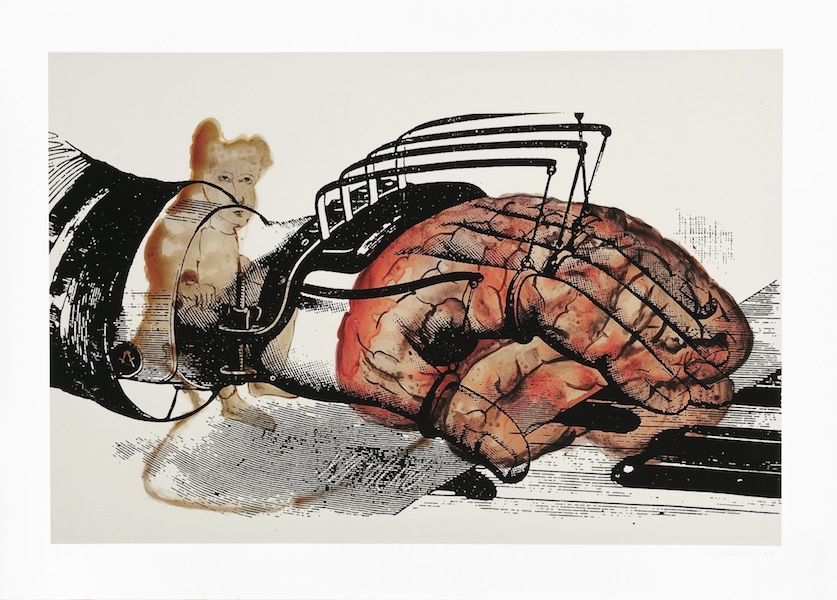
© » KADIST
Nalini Malani
Memory: Record/Erase is a stop-motion animation by Nalini Malani based on ‘The Job,’ a short story by celebrated German poet and playwright Bertolt Brecht. Brecht’s story follows a poverty-stricken family during the German depression, as the central character, Frau Hausmann, is forced to impersonate her late husband to procure his job as a nightwatchman to support her two children. Despite her exceptional performance during the job, and even after receiving public commendation for catching a thief, when eventually her identity is discovered during a factory accident she is forced into a precarious existence where she resorts to selling herself to get by.

© » KADIST
Cildo Meireles
Meireles, whose work often involves sound, refers to Sal Sem Carne (Salt Without Meat) as a “sound sculpture.” The printed images and sounds recorded on this vinyl record and it’s lithographed sleeve describe the massacre of the Krahó people of Brazil. The piece draws on Meireles’s first-hand contact with many indigenous groups through his father’s work with the Indian Protection Service. The recordings on the LP contain narrative accounts of massacres of native peoples, as well as indigenous music and rituals.

© » KADIST
Hank Willis Thomas
Drawing & Print (Drawing & Print)
Shot in black and white and printed on a glittery carborundum surface, Black Hands, White Cotton both confronts and abstracts the subject of its title. As with many of his works, the artist has taken a found image and manipulated it to draw out and dramatize the formal contrast between the black hands holding white cotton. Cotton, of course is one of the most familiar fabric sources to us, and becomes incredibly soft once processed.

© » KADIST
Hank Willis Thomas
South Africa Righteous Space by Hank Willis Thomas is concerned with history and identity, with the way race and ‘blackness’ has not only been informed but deliberately shaped and constructed by various forces – first through colonialism and slavery, and more recently through mass media and advertising – and reminds us of the financial and economic stakes that have always been involved in representations of race.

© » KADIST
Catherine Opie
Alistair Fate (1994) depicts, presumably, a member of the LGBT community. Catherine Opie is known for her portraits of LGBT, queer, and outsider people; she intends them to come off not as shocking or different, but as human despite their deviance from societal norms. This image is one of several works by Opie in the Kadist Collection that show marginalized people, filtered through the artist’s signature appropriation of formal and classical portraiture in the interest of both documentation and reframing.

© » KADIST
Catherine Opie
Although best known as a provocateur and portraitist, Opie also photographs landscapes, cityscapes, and architecture. The Freeway Series was developed in 1995, right after the artist’s inclusion in that year’s Whitney Biennial. As if suggesting that her work should not be restricted to being seen through overtly political or activist lenses, this series lends insight into the city of Los Angeles via its most characteristic urban feature: its highways.

© » KADIST
Hank Willis Thomas
Drawing & Print (Drawing & Print)
Thomas’ lenticular text-based works require viewers to shift positions as they view them in order to fully absorb their content. Meaning, therefore, changes depending on one’s perspective—and in the case of Thomas’ installation, only emerges when one knows that there is always something hidden, always more to one of his works than immediately meets the eye. This lenticular print with text shifts as you walk in front of it from its title, “Black Imitates White” to the inverse, “White Imitates Black”(and some other possibilities in between) emphasizing that there are always at least two perspectives to the same scenario, and thereby encouraging us as viewers to consider them all together rather than trying to identify with any one subjectivity.

© » KADIST
Catherine Opie
In this work, a woman sits on a couch with her shirt pulled up to expose her pierced nipples, which are connected by a chain. She wears an expression of both pleasure and intensity as she points a gun at someone or something outside of the frame. Raven (gun) (1994) is not so much threatening as full of sexuality and potential energy.
Hank Willis Thomas
- location: New York, New York
- year born: 1976
- gender: male
- nationality: American
- home town: Plainfield, New Jersey
Catherine Opie
- location: Los Angeles, California
- year born: 1961
- gender: female
- nationality: American
- home town: Sandusky, Ohio
Carlos Amorales
- year born: 1970
- gender: male
- nationality: Mexican
- home town: Mexico City, Mexico
Zanele Muholi
- year born: 1972
- gender: female
- nationality: South African
- home town: Umlazi, Durban, South Africa
Lynn Hershman Leeson
- location: San Francisco, California
- year born: 1941
- gender: female
- nationality: American
- home town: Cleveland, Ohio
Walead Beshty
- location: Los Angeles, California
- year born: 1976
- gender: male
- home town: London, United Kingdom
Ian Wallace
- year born: 1943
- gender: male
- nationality: British
- home town: Shoreham, United Kingdom
Fang Lu
Fang Lu uses intimacy as a place for self-expression in her videos and draws out mundane moments from everyday life as a strategy to heighten one’s awareness of existence from the rest of the world...
Du Zhenjun
- location: Paris, France
- location: Shanghai, China
- year born: 1961
- gender: male
- nationality: Chinese
- home town: Shanghai, China
An-My LE
- location: New York, New York
- year born: 1960
- gender: female
- home town: Saigon, Vietnam
Nalini Malani
- year born: 1946
- gender: female
- nationality: Indian
- home town: Karachi, Pakistan
Pascal Shirley
Pascal Shirley’s photographs portray a California of beaches, music festivals, families, and hipsters wandering through the hills...
Yang Guangnan
- location: New York City, United States
- year born: 1986
- home town: Inner Mongolia, China
Petra Cortright
- location: Santa Barbara, California
- year born: 1986
- gender: female
- nationality: American
Andrea Bowers
- location: Los Angeles, California
- year born: 1965
- gender: female
- nationality: American
- home town: Wilmington, Ohio
Edward Kienholz
- location: Los Angeles, California
- year born: 1927
- gender: male
- nationality: American
- home town: Fairfield, Washington
Doug Aitken
- year born: 1968
- gender: male
- nationality: American
- home town: Redondo Beach, California
Eko Nugroho
- year born: 1977
- gender: male
- nationality: Indonesian
- home town: Yogyakarta, Indonesia
Glenn Ligon
- location: New York, New York
- year born: 1960
- gender: male
- nationality: American
- home town: Bronx, New York
Diego Rivera
- location: Mexico City, Mexico
- year born: 1886
- gender: male
- nationality: Mexican
- home town: Guanajuato, Mexico
Cinthia Marcelle
- location: Belo Horizonte, Brazil
- year born: 1974
- gender: female
- nationality: Brazilian
- home town: Belo Horizonte, Brazil
Qing Zhang
- year born: 1977
- gender: male
- nationality: Chinese
- home town: Suzhou, China
Cildo Meireles
- location: Rio de Janeiro, Brazil
- year born: 1948
- gender: male
- nationality: Brazilian
- home town: Rio de Janeiro, Brazil
Harrell Fletcher
- location: Portland, Oregon
- year born: 1967
- gender: male
- nationality: American
- home town: Santa Maria, California
Kate Gilmore
- location: New York, New York
- year born: 1975
- gender: female
- nationality: American
- home town: Washington, D.C.
Piero Golia
- location: Los Angeles, California
- year born: 1974
- gender: male
- nationality: Italian
- home town: Naples, Italy
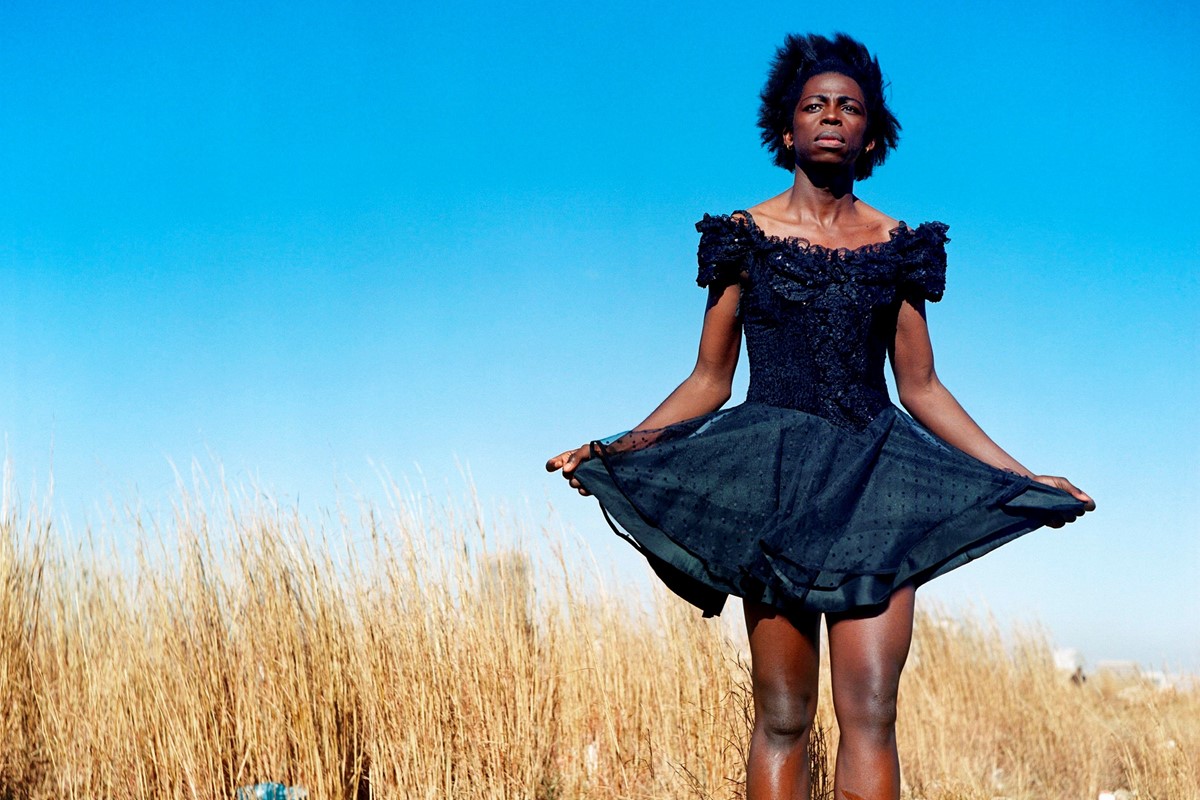
© » ANOTHER
about 17 months ago (02/12/2024)
Zanele Muholi’s Potent Portrait of South Africa’s Queer Community | AnOther As their new exhibition opens in San Francisco, Zanele Muholi talks about their powerful photos of queer survivors of hate crimes, couples in everyday moments, and self-portraits referencing history February 02, 2024 Text Emily Steer Zanele Muholi creates potent portraits...

© » APERTURE
about 19 months ago (12/01/2023)
For the past two decades, An-My Lê has used photography to examine her personal history and the legacies of US military power, probing the tension between experience and storytelling....

© » ROYAL ACADEMY
about 21 months ago (10/05/2023)
Video: Catherine Opie on photographing leading British artists | Blog | Royal Academy of Arts Catherine Opie in the RA Collection Gallery Video: Catherine Opie on photographing leading British artists Read more Become a Friend Video: Catherine Opie on photographing leading British artists Published 8 September 2023 Catherine Opie discusses her portraits of David Hockney, Anish Kapoor, Gillian Wearing, Isaac Julien and Lynette Yiadom-Boakye, featured in our free display in the Collection Gallery...
-
1940-1949
Diego Rivera
1940In 1940 Rivera came to San Francisco for what would be his last mural project in the city, Pan-American Unity ...
-
1970-1979
Cildo Meireles
1975Meireles, whose work often involves sound, refers to Sal Sem Carne (Salt Without Meat) as a “sound sculpture.” The printed images and sounds recorded on this vinyl record and it’s lithographed sleeve describe the massacre of the Krahó people of Brazil...
-
1980-1989
Edward Kienholz
1984Untitled (San Francisco) was made in Idaho in 1984 and was facetiously dedicated to Henry Hopkins, the then director of the San Francisco Museum of Art who added “modern” to its name...
Ian Wallace
1986Wallace says of his Heroes in the Street series, “The street is the site, metaphorically as well as in actuality, of all the forces of society and economics imploded upon the individual, who, moving within the dense forest of symbols of the modern city, can achieve the status of the heroic.” The hero in Study for my Heroes in the Street (Stan) is the photoconceptual artist Stan Douglas, who is depicted here (and also included in the Kadist Collection) as an archetypal figure restlessly drifting the streets of the modern world...
Catherine Opie
1987In this work, a woman sits on a couch with her shirt pulled up to expose her pierced nipples, which are connected by a chain...
Catherine Opie
1987Catherine Opie’s candid photograph Cathy (bed Self-portrait) (1987) shows the artist atop a bed wearing a negligee and a dildo; the latter is attached to a whip that she holds in her teeth...
-
1990-1999
Catherine Opie
1993Like many of Opie’s works, Mike and Sky presents female masculinity to defy a binary understanding of gender...
Catherine Opie
1994Although best known as a provocateur and portraitist, Opie also photographs landscapes, cityscapes, and architecture...
Nalini Malani
1996Memory: Record/Erase is a stop-motion animation by Nalini Malani based on ‘The Job,’ a short story by celebrated German poet and playwright Bertolt Brecht...
-
2000-2009
Ian Wallace
2000Untitled (Breathless) presents a folded newspaper article on Jean-Luc Godard’s À Bout de Souffle (Breathless)...
Glenn Ligon
Drawing & Print
2000(Drawing & Print) Glenn Ligon’s diptych, Condition Repor t is comprised of two side-by-side prints...
Harrell Fletcher
2005The American War , which takes its title from the Vietnamese term for what Americans call the Vietnam War, has toured the United States extensively with the goal of presenting a Vietnamese perspective of that history...
Carlos Amorales
Drawing & Print
2005(Drawing & Print) Produced on the occasion of an exhibition at ARTIUM of Alava, Basque Centre-Museum of Contemporary Art, this deck of cards is a selection of images from Carlos Amorales’s Liquid Archive...
Qing Zhang
2006603 Football Field presents a soccer game played inside a small student apartment in Shanghai...
Pascal Shirley
2006Gypsy shows an ambivalent scene, in which broken blinds and its unsmiling subject are balanced with the stilllife plentitude of watermelon slices and the beautifully lit nudity of the sitter...
Carlos Amorales
2006This work, a large oil painting on canvas, shows a moment from Amorales’s eight-minute two-channel video projection Useless Wonder (2006)...
Pascal Shirley
2006Like many of Pascal Shirley’s photographs, Oakland Girls aestheticizes a dingy rooftop and a cloudy sky...
Gimhongsok
2007To explore the boundaries between artwork and audience, Gimhongsok created a series of sculptural performances in which a person wearing an animal costume poses in the gallery...
Carlos Amorales
2007This work, a large oil painting on canvas, shows a moment from Amorales’s eight-minute two-channel video projection Useless Wonder (2006)...
Lynn Hershman Leeson
2007Lynn Hershman Leeson’s genre-bending documentary Strange Culture tells the story of how one man’s personal tragedy turns into persecution by a paranoid, conservative, and overzealous government...
Piero Golia
2007Golia’s Untitled 3 is an installation in which a mechanical device is programmed to shoot clay pigeons that are thrown up in front of a white wall...
Kate Gilmore
2008In the six-minute single-channel video Higher Horse , Kate Gilmore perches herself on top of a tall pile of plaster blocks, in front of a pink colored wall with vein-like streaks of red...
Eko Nugroho
2009Nugroho’s installations and performances have their roots in the shadow puppet rituals in Indonesia, particularly the Javanese Wayang tradition whose essence is in the representation of the shadows...
Yoshua Okón
2009Canned Laughter was Okón’s response to an invitation from Ciudad Juárez , Mexico, where artists were asked to create works based on their experience of the city...
Doug Aitken
2009The version of Frontier acquired by the Kadist Collection consists of a single-channel video, adapted from the monumental installation and performance that Aitken presented in Rome, by the Tiber River, in 2009...
-
2010-2019
Andrea Bowers
Drawing & Print
2010(Drawing & Print) The small drawings that comprise Study from May Day March, Los Angeles 2010 (Immigration Reform Now) and We Are Immigrants Not Terrorists are based on photographs taken at a political rally in downtown Los Angeles in which thousands of individuals demonstrated for immigrants’ rights...
An-My LE
2010The print Patient Admission, US Naval Hospital Ship Mercy, Vietnam (2010) features an Asian Buddhist monk and an American Navy Solider on board the Mercy ship –one of the two dedicated hospital ships of the United States Navy– sitting upright in their chairs and adopting the same posture...
Walead Beshty
2010Black Curl (CMY/Five Magnet: Irvine, California, March 25, 2010, Fujicolor Cyrstal Archive Super Type C, EM No 165-021, 05910) is a visually compelling photogram...
Du Zhenjun
2010The Tower of Babel is an installation of large-format photographs that forces the audience to occupy a central position through its monumental scale...
Du Zhenjun
2010The Tower of Babel is an installation of large-format photographs that forces the audience to occupy a central position through its monumental scale...
Du Zhenjun
2010The Tower of Babel is an installation of large-format photographs that forces the audience to occupy a central position through its monumental scale...
Yang Guangnan
2011Itch explores the relationship between technology and daily human experience with a motorized arm that extends from within the gallery’s wall, moving up and down while holding a projector that shows a desperately scratching pair of hands....
Walead Beshty
2011Constructed out of metal or glass to mirror the size of FedEx shipping boxes, and to fit securely inside, Walead Beshty’s FedEx works are then shipped, accruing cracks, chips, scrapes, and bruises along the way to their destination...
Petra Cortright
2011In her 2011 webcam video, Sickhands , Cortright poses before her in-computer camera, as her hands, hair, and body begin waving and rippling vertically across the screen, distorted by software effects...
Ana Teresa Fernández
Drawing & Print
2011(Drawing & Print) The artist writes about her work Borrando la Frontera, a performance done at Tijuana/San Diego border: “I visually erased the train rails that serve as a divider between the US and Mexico...
Cinthia Marcelle
2012Cinthia Marcelle’s video work Automóvel (2012) re-edits the mundane rhythms of automotive traffic into a highly compelling and seemingly choreographed meditation on sequence, motion, and time...
Hank Willis Thomas
Drawing & Print
2012(Drawing & Print) Intentionally Left Blanc alludes to the technical process of its own (non)production; a procedure known as retro-reflective screen printing in which the image is only fully brought to life through its exposure to flash lighting...
Hank Willis Thomas
Drawing & Print
2012(Drawing & Print) Thomas’ lenticular text-based works require viewers to shift positions as they view them in order to fully absorb their content...
Hank Willis Thomas
2012Like many of his other sculptural works, the source of I am the Greatest is actually a historical photograph of an identical button pin from the 1960s...
Walead Beshty
2012Constructed out of metal or glass to mirror the size of FedEx shipping boxes, and to fit securely inside, Walead Beshty’s FedEx works are then shipped, accruing cracks, chips, scrapes, and bruises along the way to their destination...
Nalini Malani
2012Malani draws upon her personal experience of the violent legacy of colonialism and de-colonization in India in this personal narrative that was shown as a colossal six channel video installation at dOCUMENTA (13), but is here adapted to single channel...
Hank Willis Thomas
2012Bread and Roses takes its name from a phrase famously used on picket signs and immortalized by the poet James Oppenheim in 1911...
Petra Cortright
2012In the flash animation SpringValle_ber_girls , Petra Cortright collages together surreal scenes out of unnaturally idyllic desktop screensavers with equally unreal computer-generated women that pop in and out of the landscape...
Hank Willis Thomas
2013The image is borrowed from protests during Civil Rights where African Americans in the south would carry signs with the same message to assert their rights against segregation and racism...
Hank Willis Thomas
Drawing & Print
2014(Drawing & Print) Shot in black and white and printed on a glittery carborundum surface, Black Hands, White Cotton both confronts and abstracts the subject of its title...
Zanele Muholi
2014As a visual activist for the rights of Lesbian, gay, bisexual, transgender, queer and intersex (LBGTQI), Muholi’s photographs radically transgress the conventional perception of lesbian and transgender communities in South Africa...
Hank Willis Thomas
2014South Africa Righteous Space by Hank Willis Thomas is concerned with history and identity, with the way race and ‘blackness’ has not only been informed but deliberately shaped and constructed by various forces – first through colonialism and slavery, and more recently through mass media and advertising – and reminds us of the financial and economic stakes that have always been involved in representations of race....
Zanele Muholi
2014As a visual activist for the rights of Lesbian, gay, bisexual, transgender, queer and intersex (LBGTQI), Muholi’s photographs radically transgress the conventional perception of lesbian and transgender communities in South Africa...
Zanele Muholi
2014As a visual activist for the rights of Lesbian, gay, bisexual, transgender, queer and intersex (LBGTQI), Muholi’s photographs radically transgress the conventional perception of lesbian and transgender communities in South Africa...
Carlos Amorales
2014Carlos Amorales, based in Mexico City, works in many media and combinations thereof, including video, drawing, painting, photography, installation, animation, and performance...
Yoshua Okón
2015Fridge-Freezer is a 2-channel video installation where Yoshua Okón explores the darker side of suburbia, d escribed by the artist as “ the ideal environment for a numb existence of passive consumerism and social a nd environmental disengagement...
Andrea Bowers
2015Bowers’ Radical Hospitality (2015) is a sculptural contradiction: its red and blue neon letters proclaim the words of the title, signaling openness and generosity, while the barbed wires that encircle the words give another message entirely...
Lynn Hershman Leeson
2016Tania Libre is a film by Lynn Hershman Leeson centered around renowned artist Tania Bruguera and her experience as a political artist and activist under the repressive government of her native Cuba...
Lynn Hershman Leeson
2017Using the seminal 1958 film Vertigo as a launchpad, Lynn Hershman Leeson explores the blurred lines between fact and fantasy in VertiGhost , a film commissioned by the Fine Arts Museums in San Francisco...
Walead Beshty
2018Office Work by Walead Beshty consists of a partially deconstructed desktop monitor screen, cleanly speared through its center onto a metal pole...
Agnieszka Kurant
Drawing & Print
2018(Drawing & Print) Agnieszka Kurant’s Placebo VIII brings together a series of imaginary pharmaceuticals invented within the fictional narratives of literature and film...
-
2020-2029
Agnieszka Kurant
2022For Sentimentite Agnieszka Kurant collaborated with Justin Lane, CEO and Co-Founder of CulturePulse, to gather global sentiment data that has been harvested from millions of Twitter and Reddit posts related to 100 seismic events in recent history...
Agnieszka Kurant
2022For Sentimentite Agnieszka Kurant collaborated with Justin Lane, CEO and Co-Founder of CulturePulse, to gather global sentiment data that has been harvested from millions of Twitter and Reddit posts related to 100 seismic events in recent history...
Agnieszka Kurant
2022For Sentimentite Agnieszka Kurant collaborated with Justin Lane, CEO and Co-Founder of CulturePulse, to gather global sentiment data that has been harvested from millions of Twitter and Reddit posts related to 100 seismic events in recent history...






